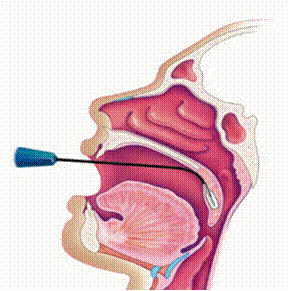|
TT Sleep |
|
Sleep Smart |



|
Surgery for Snoring and Sleep Apnea |
Surgical Options· Excision surgery· Tonsillectomy· Adenoidectomy· Nasal Surgery· Palatal surgery· Uvulopalatopharyngoplasty· Radiofrequency (RF) volumetric tissue reduction· Also called Somnoplasty· Uses radio frequency waves to remove excess tissue. |
|
Surgery is often effective in the treatment of Snoring.
It is often NOT OPTIMAL treatment for Obstructive sleep Apnea. |
|
A good article to read is Snoring Not Funny, Not Hopeless. There is uvulopalatopharyngoplasty (UPPP) or Laser-Assisted Uvulopalatoplasty (LAUP), that involves removing excess tissue from the throat. Take a look at this Canadian site for more information on snoring, sleep apnea and LAUP surgery. Uses The newest surgery, approved by the FDA in July 1997 for treating snoring is called somnoplasty |
|
What is Somnoplasty? Somnoplasty, a revolutionary surgical procedure, was developed by Somnus Medical Technologies in Sunnydale, California. FDA approved of this procedure in 1997 as a viable treatment for habitual snoring. Going by the specific technology used in this procedure, Somnoplasty is also referred to as radiofrequency (RF) volumetric tissue reduction of the palate.
Somnoplasty ie Radio Frequency Volumetric Tissue Reduction also called Radio Frequency tissue ablation is used not only to treat habitual snoring, but also chronic nasal congestion caused by enlarged turbinates. |
|
What are the different tissues involved in Radio Frequency Tissue Ablation? (RFTA)
Snoring is a result of several types of obstruction in the airway.
If snoring is a result of excessive relaxation and vibration of the tissues at the back of the nose or throat RFTA is done at the level of the soft palate by shrinking and stiffening the tissues of this area.
If snoring is caused by enlarged turbinates, then RFTA may be used to treat chronic nasal congestion and the turbinates are the prime focus of the operation. This significantly reduces the volume of the obstructing turbinates. |


|
RF Soft Palate or Inferior turbinate Treatment is a quick office procedure that takes approximately 20 minutes. Patients typically return home shortly after the procedure and can experience noticeable snoring improvement or breathing improvement within three to six weeks.
Radio frequency procedures have the following clinical advantages: · Significant post-op improvement in Epworth Sleepiness Scales at both the 3 and 9.5 month postoperative visits · Significant reduction in snoring reported by both the patient and bed partner at the 3 and 9.5 month post-operative visits1 · Minimal patient discomfort · Continual symptomatic improvement over time due to tissue shrinkage |
|
Take the first step towards a better night's sleep and a healthier lifestyle for you and your bed partner.
Make an appointment at TT Sleep for an evaluation today. Call 657 7636 for your appointment.
RFTA ( Somnoplasty) is an effective Rx for Nasal Congestion |
|
How does Radio Frequency Tissue Ablation work ?
Essentially, RFTA procedure uses low levels of radiofrequency thermal energy on the relevant sections of the uvula ,the soft palate , tongue or the nasal mucosa with the aim of freeing the air passage of any obstruction.
Depending on the nature of the obstruction, the tongue, throat soft palate or the nasal mucosa could be pierced with a sterilized, disposable needle, called the electrode. This is further connected to a low-intensity radiofrequency heat generator. The concerned tissues are heated with the help of the electrode, to a temperature between 158 and 176 degrees
The heat energy creates very small burn areas in the sections where it has been applied. However, over 4 to 6 weeks these get re-absorbed by the body. This in effect, reduces the volume of tissues, as well as renders them stiff, so that snoring is substantially reduced or eliminated.
While the burning causes the inner tissues attached to the concerned obstructive muscle to shrink, the tissues located on the outside (and may contain taste buds, etc) are left untouched. |
|
How long does it take for RFTA to be completed?
This simple and non-invasive surgical intervention uses only local anesthesia and is done at the doctors’ office.
While one session of somnoplasty may take less than 30 minutes, you may need more than one session, depending on the severity of snoring, to get the desired results.
The second session is usually arranged after 6 to 8 weeks of the first procedure.
|
|
There is one snoring surgery that is least invasive and almost painless.
Many names... same procedure
· Somnoplasty
· Radio frequency volumetric tissue reduction or RFTVR
· Radio frequency tissue ablation or RFTA, |
|
Will RFTA cause me any pain?
No matter what kind of surgery you opt for, it is bound to involve some amount of pain and risks.
So a local anaesthetic is required
Unlike other surgical procedures though, RFTA is relatively less painful, though there will be some minor swelling and an uncomfortable feeling immediately after the procedure.
|
|
Complications of RFTA
The RFTA procedure is quite similar to any outpatient surgical intervention. A few of the most common RFTA complications include bleeding, infection, and sore throat.. . |
|
Iranian Man Divorcing Wife for Snoring -- True story from Fox News, February 18,1997 |

|
Phone: 868 657 7636
Fax: 868 652 0053
E-mail: steve.medford@gmail.com ttsleep@gmail.com |